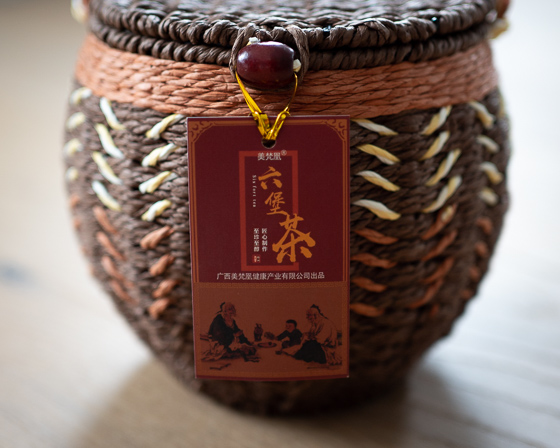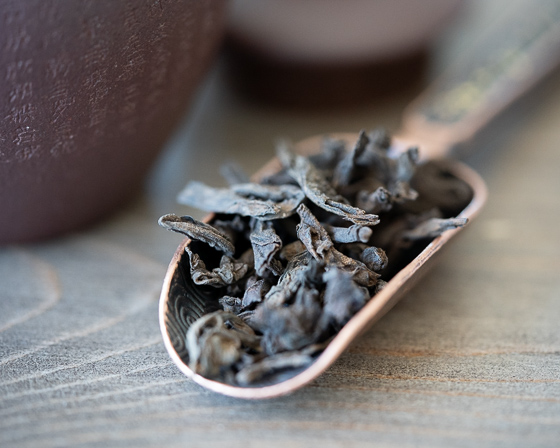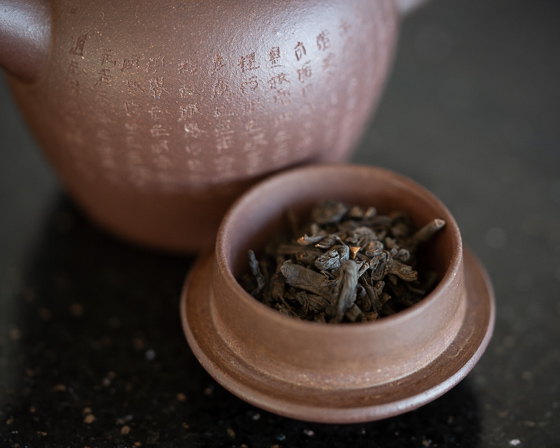An Introduction to Liu Bao tea
Table of Contents

Figure 1: 2012 Liubao Tea Wuzhou Guangxi Special Grade (IG)
1. Overview
Liu Bao ( 六堡 ) is a type of dark tea ( 黑茶 ) that is made in Guangxi, with references to it in historical tea records dating back to the Tang Dynasty (618-907 AD).
The tea is fermented using a wet piling technique. This process was the inspiration for Shou puer. Liu Bao tea can be consumed young, but is more often aged before drinking.
The name translates as “six castles”, referring to the forts that existed in the specific part of Guangxi long ago. The “forts” of the time were made of wood, and did not last to the modern age.
2. How to Brew Liu Bao tea
Liu Bao requires boiling water to get it to open up. You can brew it Gong fu style in either a Gaiwan or a pot. You may also go well boiling it, however I haven’t tried that style.
I usually brew with around 5-7g/100mL water, and start with a rinse of about 15s, and then follow with infusions of around 10s. For older tea, I may go for a longer rinse, to offset some of the mustiness.
Liu Bao has a darker profile than many teas, and often reminds me of forest undergrowth, with a wet, woody vibe. It comes into its own a few steeps in, with a very smooth mouthfeel, and long relaxed sessions.
3. Types & Processing
Liu Bao is a wide category of tea, with many dimensions to explore. I’ve included some of the different types, but there is often new ones emerging, or new aspects to consider. It is part of what makes Liu Bao fun.
- Ripe ( 熟 ) / Raw ( 生 ) - ripe undergoes wet pilling, a controlled fermentation process, Wo Dui ( 渥堆 ), that accelerates flavour development. Liu Bao wet piling is typically lower intensity than ripe Puer tea. Most factory teas will be ripe. Raw skips the wet piling, and often requires longer aging.
- Aged / New - it is rare to get very early tea in a given year, typically you’ll find things that are one to two years old. This is due to the time it takes to develop the initial profile of the tea. Liu Bao is often sold aged, and I’ve seen some available from the 1970’s and 1980’s. These older teas can get quite musty in profile, and have a strong clean energy.
- Farmer / Factory - Most Liu Bao is produced in large factories now, using controlled processes, including wet piling. You can also find “farmer” tea, which is typically made at the farm where the leaves are picked. The quality of leaves and buds are usually a mix of what was available, and not specifically graded.
Liu Bao is packaged in a range of different types. Most common is in a basket or loose leaf. You may also see it compressed into a brick, cake, tuo or even small coins for individual brewing.
4. History
Liu Bao translates simply as Six Castles, and was inspired by the old forts common in Guangxi. Liu Bao is a very old type of tea, with signs that it was first made in the Tang Dynasty (618 - 907). It became popular during the Qing Dynasty (1644 - 1912), and was used for health & beauty.
The processing likley changed, as there is evidence that the wet piling technique was added around 1957 in Guangxi Province, which went on to influence Ripe Puer.
Liu Bao took off in southern China, and become particularly popular around Hong Kong and Macao. With the migration many Cantonese to Malaysia to work the tin mines from 1847 - 1880, it became a very common tea there. You’ll often come across aged tea that was Malasian stored.
In recent years, it has not been as popular, with Puer tea taking more of a center stage. There is a growing community in the West that is discovering the wide range this tea has to offer.
For a detailed history of Liu Bao, Global Tea Hut has a great article here.

Figure 2: 2007 4 Gold Coins (Si Jin Qian) Liu Bao from Lao Tea Shop (IG)
5. Factories
Traditionally, Liu Bao was produced in the homes of tea farmers, however this style is rarely seen anymore. Most production comes from large factories.
Some of the factories you’ll come across include:
- Three Cranes ( 三鹤 ) – one of the most popular brands of Liu Bao, you can often find this available in Western vendors, with many varieties and ages. Yunnan Sourcing has a big range to choose from here.
- Guangxi Wuzhou Tea Factory ( 梧州广西 ) – The parent company behind the Three Cranes tea brand.
- 4 Gold Coins (Si Jin Qian) – another very famous brand, considered a “Hong Kong” style of Liu Bao. Lao Tea Shop has a good range here.
- Guangxi Wuzhou Yintai ( 广西梧州市银泰 ) – A smaller production of Liu Bao tea. I haven’t seen so many of these in Western markets, but they have a good range on Taobao.
- Zhongcha ( 中茶 ) – also known as CNNP, it is a trading company that I know of more for Puer tea. However, they also have an extensive range of Liu Bao tea to explore.
6. Notable vendors
While not as common as Puer, there are a number of vendors with extensive selections of Liu Bao that are available in English and ship internationally:
- Three Bears Tea – established in 2020, they have a wide range of ages, types and vendors of Liu Bao. TeaDB reviewed some of their tea here. I’ve ordered much of their range, and I can highly recommend them.
- Purple Tea House – wide range of Liu Bao. I’ve heard good things, but I have not personally ordered from them (EU shipping was pricing)
- Yunnan Sourcing – reasonable range, with mostly Three Cranes tea. Ships from China.
- Lao Tea Shop – EU based vendor with a good range of Liu Bao tea. I found 4 Gold Coins here, and was very happy. I heard about this vendor from tea-adventures.net.
- Teas We Like – often you’ll find high quality rarer Liu Bao here.
- TaoBao – if you are comfortable with Mandarin, you can find a huge range of Liu Bao in China, and it isn’t too tricky to ship internationally, but does require using an agent (or a local friend). I’ve had success with Meifanhuang Tea and Three Cranes via Superbuy.
7. Going deeper
- Global Tea Hut – going back through the articles published in the magazine, you’ll find a wealth of information on Liu Bao types, history, and brewing styles. The December 2016 edition in particular, focused on Liu Bao.
- TeaDB – James & Denny have reviewed quite a few Liu Bao’s, and it is a great way to explore the teas.
- 中国六堡茶 – this book is the most comprehensive information I’ve found on Liu Bao, however it is only available in Mandarin.
And if I’ve missed anything or you have questions, please message me on Twitter or Mastodon.

Figure 3: 2008 Golden Flowers Shu Liu Bao from Three Bears Tea (IG)